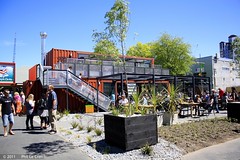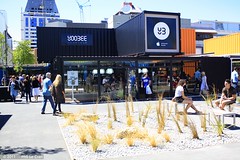
Search
Images for CBD; more images...
He's Not Heavy, He's My Brother
Images, UC QuakeStudies
A large concrete beam, still partially connected by reinforcing rods to the partially-demolished building it came from lies across an entranceway.
Modern Art or Old Fashioned Disaster
Images, UC QuakeStudies
Boarded-up broken windows on the old Christchurch City Council building in Tuam Street. The photographer comments, "What can happen to a building when the land is no longer solid as a rock".
Lawrie and Wilson Auctioneers
Images, UC QuakeStudies
A digitally manipulated image of the Lawrie and Wilson Auctioneers building on Tuam Street. The photographer comments, "This building at 210 Tuam Street is still off limits after the Christchurch earthquake. It has Lawrie and Wilson Auctioneers at the top and Christchurch City Council below. In the past it had a City Photography and at a different time a Parking Unit sign".
Manawatu Standard Image: Stacy Squires 2010:12:13 10:10:00
Images, UC QuakeStudies
Photograph captioned by Fairfax, "Christchurch CBD was 'yarn-bombed' during the weekend using yarn and fabric pieces to brighten public areas and earthquake-affected spaces. Hope sign at Hereford and Manchester Streets".
The Southland Times Image: Stacy Squires 2010:12:13 10:03:28
Images, UC QuakeStudies
Photograph captioned by Fairfax, "Christchurch CBD was 'yarn-bombed' during the weekend using yarn and fabric pieces to brighten public areas and earthquake-affected spaces. Hope sign at Hereford and Manchester Streets".
The Southland Times Image: Stacy Squires 2010:12:13 10:04:02
Images, UC QuakeStudies
Photograph captioned by Fairfax, "Christchurch CBD was 'yarn-bombed' during the weekend using yarn and fabric pieces to brighten public areas and earthquake-affected spaces. Hope sign at Hereford and Manchester Streets".
Slane, Christopher, 1957-: "A level playing field, excellent. Now we can l…
Images, Alexander Turnbull Library
ACT leader Rodney Hide stands alone in the middle of a blasted plain that was once the 'Christchurch CBD' and says 'A level playing field, excellent. Now we can leave the rest to the market'. Context - Christchurch after the earthquakes of 4 September 2010 and 22 February 2011. ACT explicitly promotes a free market philosophy - a (literal) level playing field in the Christchurch CBD sounds like an excellent opportunity to test the powers of the free market. Quantity: 1 digital cartoon(s).
APEC project on SME Resilience, Resilient Organisations monthly reports Re…
Research papers, University of Canterbury Library
The earthquake sequence has resulted in significant physical and reputational damage to the Canterbury tourism industry. Eighteen months after the earthquakes inbound tourism data is still below pre-earthquake levels, with Canterbury operators reporting that the industry has not bounced back to where it was before September 2010. Outcomes of the earthquakes on business performance highlight there were winners and losers in the aftermath. Recovery of inbound tourism markets is closely tied to the timeframe to rebuild the CBD of Christchurch. Reinstating critical tourism infrastructure will drive future tourism investment, and allow tourism businesses to regenerate and thrive into the future. A blueprint for rebuilding the CBD of Christchurch was released by the Christchurch City Council in July 2012, and has been well received by tourism stakeholders in the region. The challenge now is for city officials to fund the development projects outlined in the blueprint, and to rebuild the CBD as quickly as possible in order to help regenerate the tourism industry in Christchurch, Canterbury and the rest of the South Island
Elevated garden city : rebuilding our beloved Christchurch for the 21st ce…
Other, National Library of New Zealand
Created to generate support for and develop the idea of the Christchurch CBD being rebuilt as the world's first elevated garden city, with rooftop gardens and open spaces connected by walkways and cycle paths.
Christchurch business closures
Audio, Radio New Zealand
Christchurch central seems to have a business micro-climate. And right now it's chilly. The CBD is nothing like it used to be before the 2011 earthquake and those businesses that re-opened say they really had no choice because of the demands of insurance companies.
Christchurch: The value of a city
Videos, UC QuakeStudies
A short video-documentary featuring four Christchurch locals who reflect on the destruction of the city's CBD, and how it has changed what they value in a city. Produced with funding from NZ on Air.
Spence Kingi Commemorative Art Work
Images, UC QuakeStudies
A graffiti-style recruitment advertisement for the NZ Police, depicting police officer Spence Kingi pulling a woman from the rubble.
Police Art on Montreal St, Christchurch
Images, UC QuakeStudies
A graffiti-style recruitment advertisement for the NZ Police, depicting police officer Spence Kingi pulling a woman from the rubble.
Parking in the Red Zone
Images, UC QuakeStudies
A digitally manipulated photograph of the car parking building on the corner of Manchester and Gloucester Streets. The photographer comments, "Whilst on a tour of the Christchurch earthquake red zone we passed this car park, which I always liked due to its American outgoing feel
A Window to the Past
Images, UC QuakeStudies
A bollard covered in tattered posters. The photographer comments, "After the Christchurch February 2011 earthquake no more adverts were pasted onto this advertising pillar. Over a year later the posters are starting to peel off and reveal older ones. It seems that the constant addition of new posters was keeping everything in equilibrium, but with no new posters everything is literally falling apart".
The State of Christchurch Heritage
Images, UC QuakeStudies
A digitally manipulated image of a broken window. The photographer comments, "There is hardly anything left of Christchurch's proud heritage buildings. Most older buildings were made of brick and though they should have had improvements to make them withstand a medium earthquake most did not. They were badly damaged when hit with a series of earthquakes that were up to 2.2g at the epicentre and 1.88g in the City".
The Bandsmen's Memorial
Images, UC QuakeStudies
A digitally manipulated image of the Bandsmen's Memorial in Hagley Park. The photographer comments, "This memorial in Hagley Park in Christchurch can no longer be used due to large cracks at the base of most columns. This was mostly caused by the earthquake in February 2011, but later earthquakes have made the memorial even more dangerous".
Christchurch Press Infographic: 29 November 2012 (1)
Images, UC QuakeStudies
A map showing the location of properties being purchased by the Crown for the frame and bus interchange.
Living in an Earthquake Zone Can Be Unreal
Images, UC QuakeStudies
A photograph of a damaged house has been reflected in the lower part of the image and digitally manipulated.
The Not So Grand Entrance to the Grand Plaza in Christchurch
Images, UC QuakeStudies
A view through a gap in the partially-demolished Crowne Plaza Hotel to the Forsyth Barr building.
Double Glazing Can Keep More Than the Warmth In
Images, UC QuakeStudies
Building rubble from a partially-demolished building is piled behind and partly against a large display window.
A few of our favourite things…
Articles, Christchurch uncovered
Over the last few weeks, we’ve been excavating a site in the CBD that’s yielded some of the most interesting artefacts we’ve see for a while. So, today on the blog, we’ve selected a few of these fascinating things for … Continue reading →
Christchurch Press 15 October 2011: Section A, Page 1 (South Island Editio…
Articles, UC QuakeStudies
Page 1 of Section A of the South Island edition of the Christchurch Press, published on Saturday 15 October 2011.
Open Plan Living and Good Indoor/Outdoor Flow
Images, UC QuakeStudies
A brick wall has fallen from this house, exposing the rooms within and leaving a pile of rubble in front. The ceiling has slumped and is held up with jacks. The photographer comments, "This was probably the result of the shallower February Christchurch earthquake rather than the bigger September one".
Titanic 3D
Images, UC QuakeStudies
The roof of this collapsed building on Atlas Lane has fallen almost intact on top of the rubble. The photographer comments, "Whenever I go past this place it reminds me of a sinking ship".
Two Coffees and a Muffin to Takeaway
Images, UC QuakeStudies
Two cardboard coffee cups in a takeaway tray sit on a wooden counter. The photographer comments, "What is the story of these coffees and that sad muffin? Were these an order when the earthquake struck Christchurch on 22 February 2011? Were these a workman's and a colleague's having a quick coffee break when a later aftershock caused them to leave everything behind when they fled the red zoned building, or were they just forgotten when the building was cleared out and abandoned?".
Christchurch's White Lights of Hope
Images, UC QuakeStudies
Seen from Cambridge Terrace, the 'White Lights of Hope' spotlights shine into the sky behind a crane and damaged buildings on Oxford Terrace.
Bringing the house down
Images, eqnz.chch.2010
www.youtube.com/watch?v=SPXqb7k4azU Details inside a half demolished theatre in central Christchurch. November, 2012. Christchurch, NZ. (c)Mike Brebner. All rights reserved.
Getting Smaller
Images, eqnz.chch.2010
Demolition underway on the old Government Life building on a walk around the city September 7, 2014 Christchurch New Zealand.
What Light Through Yonder Window Breaks?
Images, UC QuakeStudies
Broken stained glass in a window of the ChristChurch Cathedral. The photographer comments, "I only managed to get one picture of the badly earthquake damaged Christchurch Cathedral and I did not want to get the buttresses holding it up like some Medieval siege engine, so I thought this one was perfect. Looking through the window notice that the adjacent wall has gone and the blue windows belong to an office block across the road".



